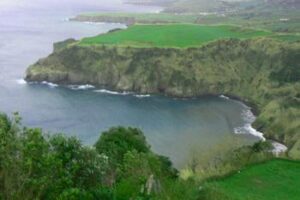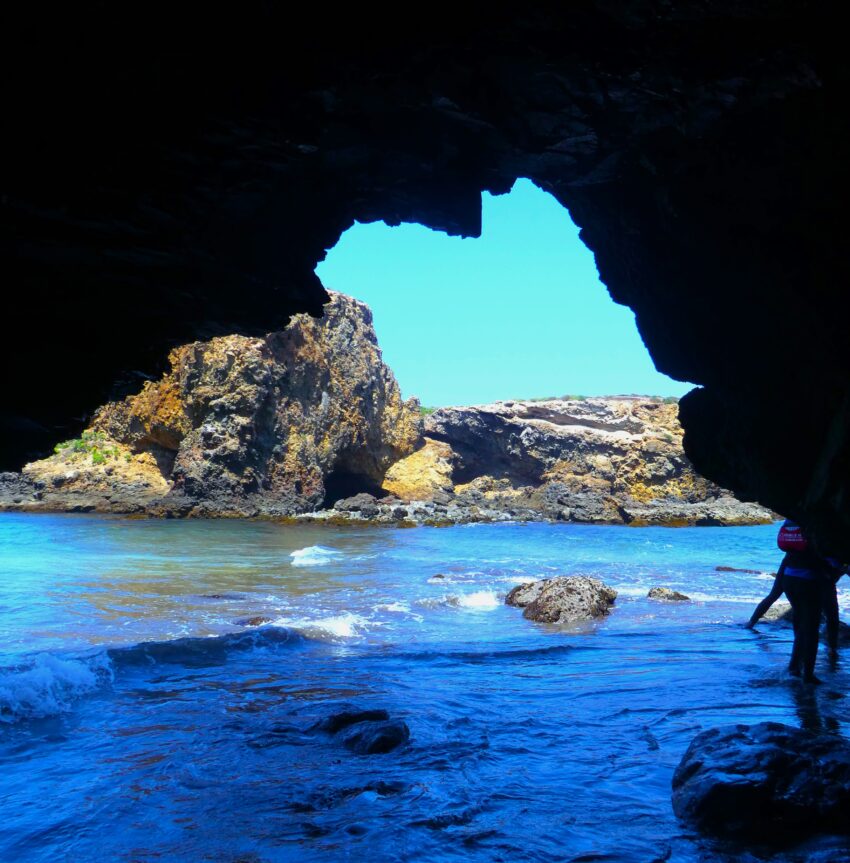
Hikes, Kayaks, Caves, and Blowholes of California’s Channel Islands
By Noreen Kompanik
GoNOMAD Senior Writer

It seems like my husband and I have gotten older, the more adventurous we’ve become! This is why the opportunity to spend a day exploring California’s magnificent Channel Islands was yet another siren call to us. We love the outdoors, nature, and especially those crazy adventures on the high seas. So, we figured, why not take the plunge on yet another exciting day-trip escapade?
So off we went to paddle and explore the deepest volcanic sea caves in the world.
About the Channel Islands
Channel Islands National Park encompasses five of the eight Channel Islands off California’s Pacific Coast, including Santa Cruz, Anacapa, Santa Rose, Santa Barbara, and San Miguel.
The chain of relatively undeveloped islands has often been called “America’s Galapagos” due to their rich biodiversity.
First colonized by the Chumash and Tongva Native Americans over 13,000 years ago, this archipelago of untouched natural beauty is home to more than 2,000 plants and wildlife. Many are so endemic that they can’t be found anywhere else in the world. Its marine life ranges from microscopic plankton to the blue whale, the largest animal to live on Earth.
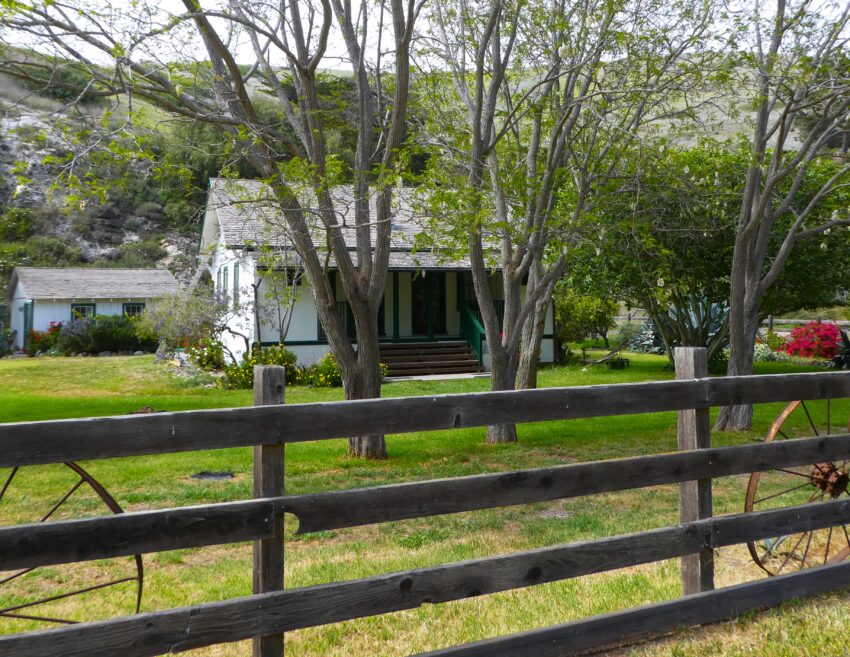
The park, which is the least visited of the U.S. national parks due to its remoteness, covers almost 250,000 acres. 80,000 of these are federally protected. The park’s main purpose is to preserve and protect the wealth of magnificent natural, cultural, and archeological resources of this coastal California treasure.
Today it stands as one of California’s most exotic and pristine offshore destinations. And all of its eight islands have been a UNESCO-listed biosphere since 1976. This is a place where you can step back in time and experience coastal southern California the way it was originally. And that’s an absolute gift.
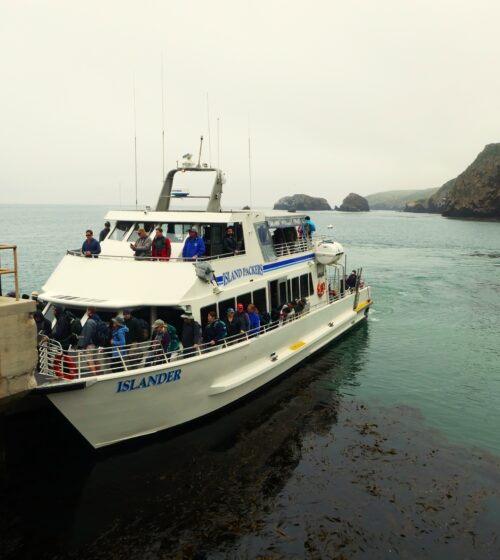
Getting to the Islands
Picturesque Ventura Harbor was our departure point for the Channel Islands, 40 miles from the mainland. After checking in with our guides at Island Packers, we were off on our outdoor adventure.
Pods of playful dolphins intermittently became our escort party during the comfortable and scenic 90-minute ferry ride. Guests can also reach the island from Santa Barbara by yachts helmed by U.S. Coast Guard captains.
Our first thoughts as we neared our drop-off at the pier in Santa Cruz’s remote Scorpion Cove was “wow, we’re not far from the mainland, yet these islands seem like a world away.” They are a delightful break from the clamor and congestion of urban life offering nature lovers a true taste of paradise.
Readying for our Kayaking Adventure
After fitted with wetsuits, life jackets, helmets, and instructions, our small group led by a well-versed professional guide headed out for our three-mile, three-hour sea kayaking adventure. And were we greeted with a picture-perfect day for our exciting experience on the crystalline waters surrounding the island.
Adventurers could choose between one and two-man kayaks. We chose a two-man paddler, me sitting in the front, my husband Michael in the back manning the rudder. I’m not sure we were prepared for the clarity of the cold Pacific Ocean waters with its deep kelp forests reaching out like bizarre floating tentacles of an alien form. But it was beautiful, calm, and serene, especially when we got to hold those glorious pink sea stars.

Heading to the Sea Caves
Sculpted by the relentless ocean surge, some of the most beautiful sea caves in the world are located along the Santa Cruz shoreline near Scorpion Anchorage.
And Santa Cruz Island sports the highest density of sea caves in the world. These impressive caverns were formed when faults in the volcanic rocks were exposed to the relentless forces of waves and winds.
The most famous of these is the Painted Sea Cave. This enormous multi-chambered sea cavern is the longest in North America, cutting its way a ¼-mile into the island of Santa Cruz. The ceiling entrance alone towers an impressive 160 feet high, and the cave is 1,300 feet deep.
Our guide let riders know that the sea state and the sea level would determine how far we could get into the cave. Under ideal conditions, a 60-foot boat could navigate almost halfway through the tunnel. Kayakers can go even deeper.
Accessing the Famous Painted Cave
Sea states and tides luckily were in our favor, though we had to follow our guide’s implicit instructions on how to enter the cave. Timing was of the essence in working with the perfect wave action so we wouldn’t be thrown against the massive craggy rocks by dangerous incoming waves.
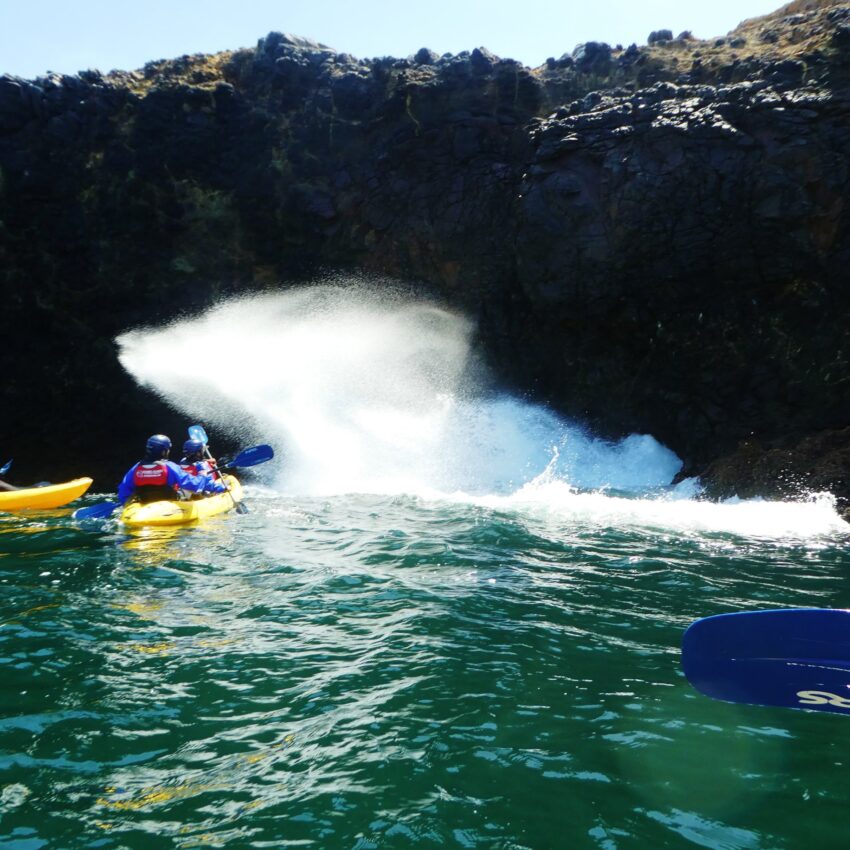
Thankfully, on our second try were able to safely access the Painted Cave. We were witness to its magnificent splendor created by freshwater seeping through its cavern walls. This constant flow gives life to the algae and colorful lichen that gave this cave its perfectly descriptive name.
It did however feel as though we were entering the belly of the whale in almost complete darkness except for the light from our flashlights. Sea lion barks echoed off the walls of the chambers, and when they took an occasional break, we listened to the lullabies of the tidal swells entering and leaving the cave. It was a surreal, unique, and unforgettable experience in a place we had never known existed.
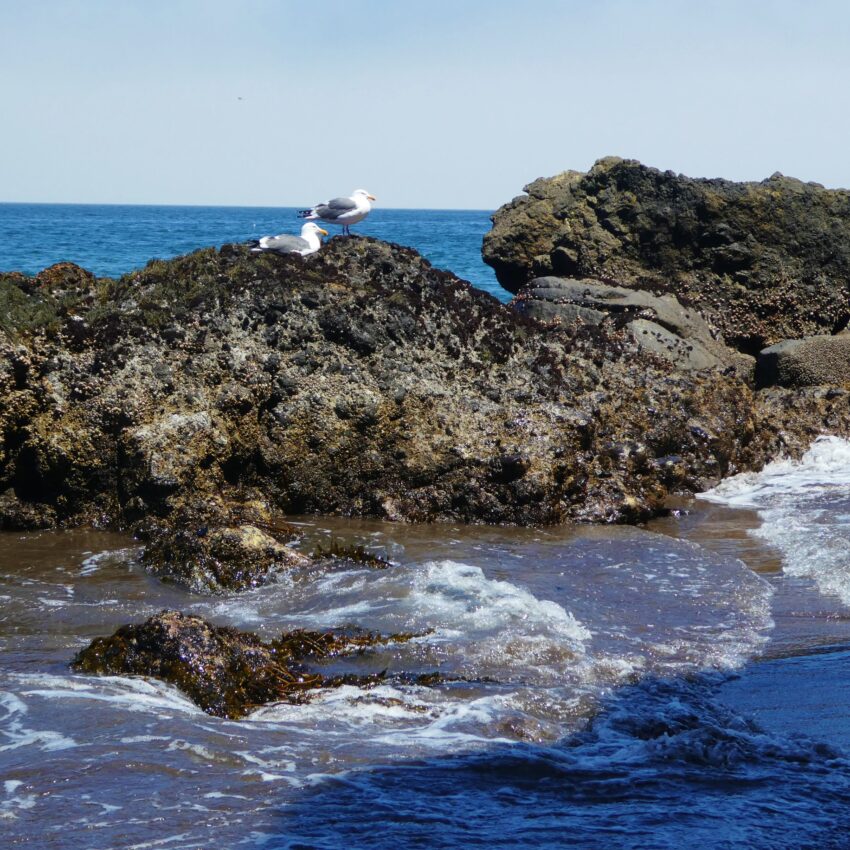
Thankfully, leaving the cave while riding an outbound wave went a bit smoother than our entrance.
Even More Stunning Sea Caves
Paddling through more ocean waves and over a few rocks, we entered several small grottos and more cavernous openings. Each cave carved into the towering cliffs seemed more exciting than the one before. Though we’d heard them described by others, nothing could possibly compete with seeing these natural wonderments with our own eyes. We kept thinking we’d seen the best, and then entered yet another even more unbelievable cavernous realm sculpted by Mother Nature’s gifts.
At one of the caves, we were able to beach our kayaks and explore more of these dramatic caverns on foot. My husband exclaimed “it feels like we’re journeying to the center of the Earth.” It was a nice break from the kayaking, as the Pacific waters seemed to be churning a bit more than when we started. And we could definitely feel the challenging workout in our arms and thighs.
After some water and snacks, kayakers had the opportunity to either head back to Scorpion Cove with one of the guides or continue on to our next adventure–the blowhole. Half of our group bailed, but Michael and I were determined to finish this kayaking adventure and feed our curiosity about what lay around the next Pacific bend. We weren’t about to miss out on anything.

Witnessing the Blowhole
If the sea caves weren’t amazing enough, we witnessed our first ocean blowhole up close and personal. Blowholes are caused when powerful waves hit the coast and water rushing into the cave’s crevices bursts back out in a high-pressure release. The phenomenon is accompanied by a booming sound and in our case, a large wide, horizontal spray soaking the paddlers.
Our guide announced that the ocean water shooting 100-feet forward and 50-feet high was one of the most impressive blowhole action he’d seen in over a year. Lucky for us the conditions were perfect that day making this one of the most unique and exciting ocean kayaking experiences we’d ever had. The screams and laughter of the other kayakers bore witness to our own excitement.
Though we’d had an incredible time, we were more than ready to beach our kayaks as the wind began to work against us on our return trip. We even had to navigate through a rough surf breaking over a sandbar. But it so was worth it, and the kayakers that had chosen to return part way through the adventure regretted they’d missed the blowhole spectacle.
For us boomers, we were so proud and thankful we could hang with the guides and much younger kayakers for the entire sea kayaking experience.
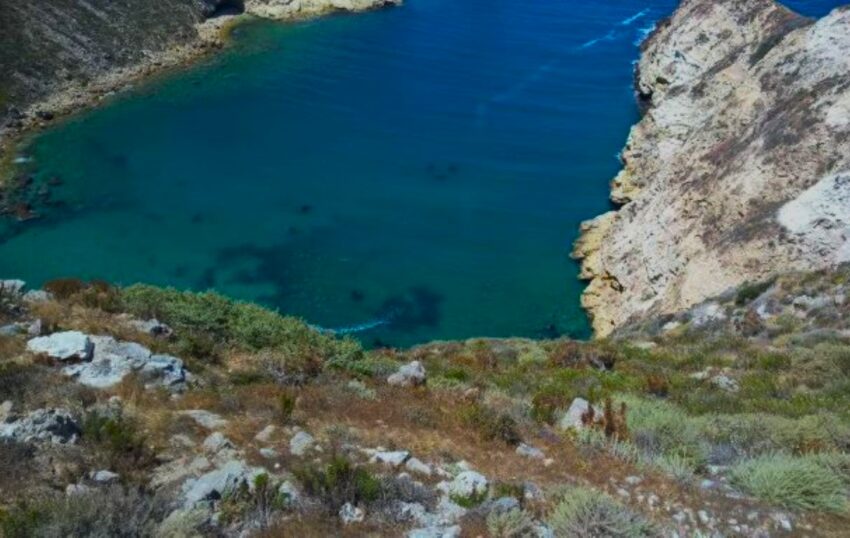
Time to Explore the Island
After a protein-packed lunch and break and visit by a tiny cat-sized island fox, we headed out to explore Santa Cruz. Though we were tempted to give our little friend a treat, we knew that it’s illegal to feed the island critters, and doing so would interfere with their natural ability to search for their own food. We complied, but he was so cute, it broke our hearts.
Santa Cruz is the largest of the Channel Islands archipelago, 22 miles long and varying from two to six miles wide with steep cliffs, coves, and sandy beaches. Devil’s Peak is the highest point on the island sitting at over 2,450 feet. For a small island, it’s impressive that Santa Cruz has over 600 indigenous plant species growing in its marshes, grasslands, and chaparral pine forests. 140 land bird and 11 land mammal species also call this island home.

15 trails ranging from flat well-maintained routes to rugged mountainous paths traverse the island’s eastern portion providing visitors like us with multiple spectacular hiking opportunities. We spotted several Santa Cruz scrub jays, a bald eagle, several smaller island fox, and a great variety of plants and wildflowers.
But it was the views at the top that made our hike worthwhile with their spectacular coastal vistas. We’re glad we brought our binoculars along as it enabled us to get a much closer look of nature at its finest.
Camping reservations year-round are required for those wishing to spend more than a day on Santa Cruz. There are no other island accommodations. All food and supplies must be brought in and taken out as there are no stores or restaurants here. However, the campground is equipped with picnic tables and pit toilets.
Vestiges of the island’s ranching era are preserved such as adobe houses, barns, blacksmiths and saddle shops all located not far from the pier. A small visitor center is located in the historic Scorpion ranch house providing a glimpse to island life in an earlier time.
Heading Back to Ventura
It was 4 pm and as we boarded the ferry back to the mainland, we both concurred that our Channel Islands trip was even better than we could have ever imagined. The weather, sea states, tides, and our incredible guides helped make this day of adventure one we’ll long remember.
Dutch travel writer Jay Maarten Troost said: “Paradise was always over there, a day’s sail away.” And it was.
We’re sure glad we found it in this remote California nature island treasure.
- Lassen Volcanic National Park: California’s Least-Visited - July 19, 2024
- Exploring Colmar, France: Alsace’s Fairytale Town - June 6, 2024
- Genoa Italy’s Charms Didn’t Elude Her - May 10, 2024





